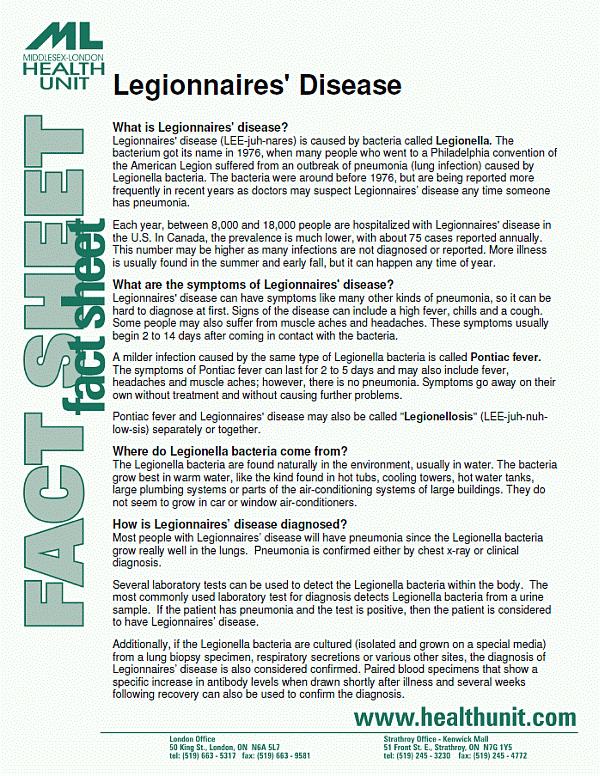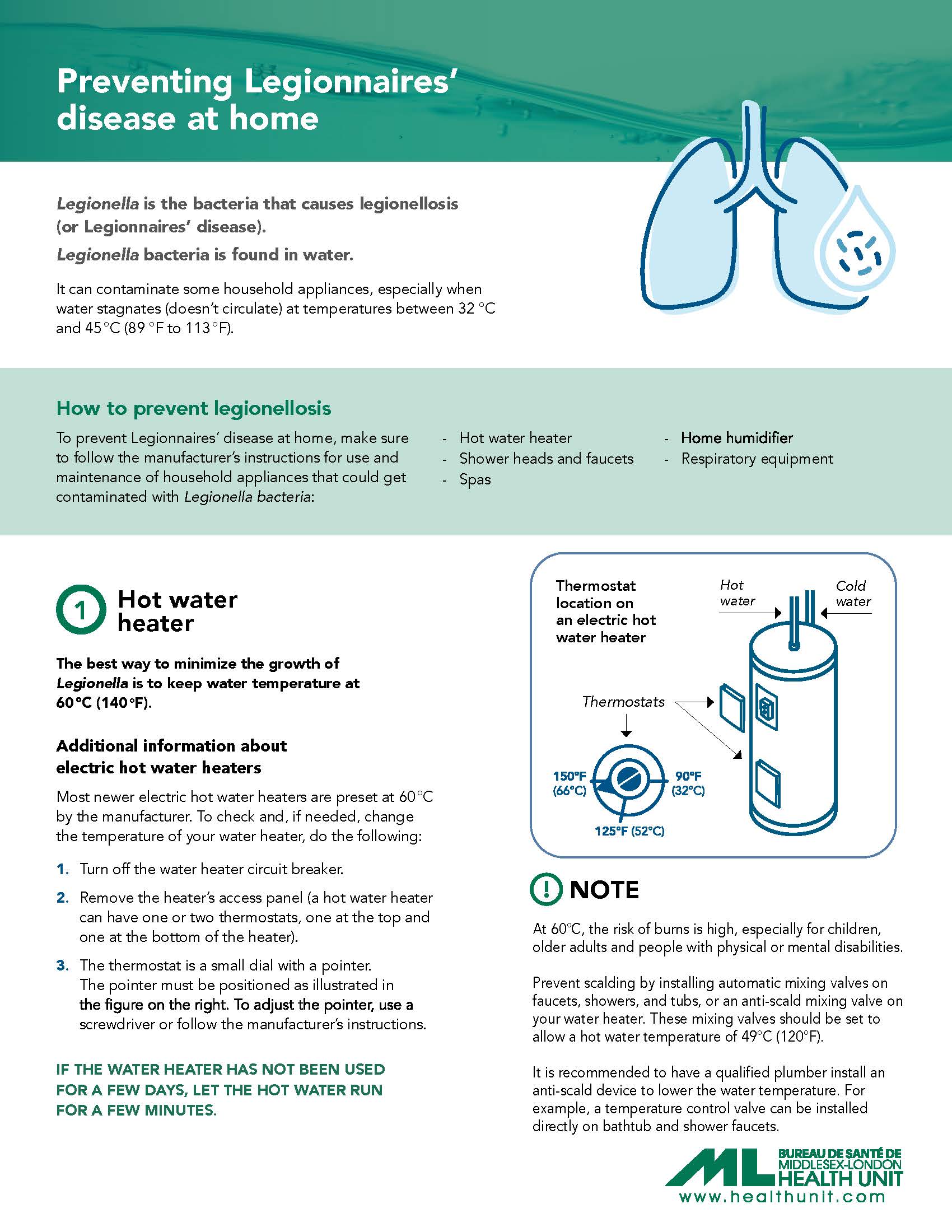What are the symptoms of Legionnaires' disease?
Legionnaires' disease can have symptoms like many other kinds of pneumonia, so it can be hard to diagnose at first. Signs of the disease can include:
Some people may also suffer from:
These symptoms usually begin two to ten days after coming in contact with the bacteria.
Pontiac Fever
A milder infection caused by the same type of Legionella bacteria is called Pontiac fever. The symptoms of Pontiac fever can last for 2 to 5 days and may also include:
- fever,
- headaches and
- muscle aches;
however, there is no pneumonia. These symptoms usually begin five to 72 hours after coming in contact with the bacteria. Symptoms go away on their own without treatment and without causing further problems.
Pontiac fever and Legionnaires' disease may also be called "Legionellosis" (LEE-juh-nuh-low-sis) separately or together.
Back to top
Where do Legionella bacteria come from?
Legionella bacteria occur naturally in soil and water, especially warm water. They can contaminate and grow in environments such as hot tubs, cooling towers, hot water tanks, large plumbing systems, parts of air-conditioning systems in large buildings, and decorative pools or fountains. They typically do not grow in car or window air-conditioners. When systems are not properly cleaned and disinfected, the bacteria can multiply and become aerosolized into the air as steam or mist through wind, fans, or vents. People can become infected by inhaling this contaminated mist. Legionella is not spread from person to person.
Back to top
How is Legionnaires’ disease diagnosed?
Most people with Legionnaires’ disease will have pneumonia since the Legionella bacteria grow really well in the lungs. Pneumonia is confirmed either by chest x-ray or clinical diagnosis.
Several laboratory tests can be used to detect the Legionella bacteria within the body. The most commonly used laboratory test looks for Legionella bacteria in a urine sample. If a person has pneumonia and the urine test is positive, then the person is considered to have Legionnaires’ disease.
Additionally, finding Legionella bacteria from lung tissue, respiratory secretions or various other sites can confirm Legionnaires’ disease. Two blood specimens that show a specific increase in antibody levels when drawn shortly after illness and several weeks following recovery can also be used to confirm the diagnosis.
Back to top
Is Legionnaires’ disease serious? Can it be treated?
Legionnaires' disease can be very serious and can cause death in 5% to 30% of cases. Most cases can be treated successfully with medications that can kill the bacteria. Healthy people usually recover from infection.
Back to top
Am I at risk for Legionnaires’ disease?
Not everyone exposed to the Legionella bacteria will get sick. People most at risk of getting sick from the bacteria are:
- the elderly (65 years of age or older)
- people who are smokers
- individuals who have a chronic lung disease (like emphysema)
- people who have weak immune systems from diseases like cancer, diabetes or kidney failure
- people who take drugs to suppress (weaken) the immune system (like after a transplant operation or chemotherapy)
Back to top
How do I get Legionnaires' disease?
Legionnaires' disease happens when someone at risk breathes in a mist or vapour (small droplets of water in the air) that has been contaminated with the bacteria, for example, the steam from a whirlpool spa that has not been properly cleaned and disinfected.
The bacteria are NOT spread person to person.
Outbreaks are when two or more people become ill in the same place at about the same time, such as patients in hospitals. Hospital buildings have complex water systems, and many people in hospitals already have illnesses that increase their risk for Legionella infection.
Other outbreaks have been linked to aerosol sources in the community, or with cruise ships and hotels. The most likely sources are whirlpool spas, cooling towers (air-conditioning units from large buildings) and water used for drinking and bathing.
Back to top
What should I do if I think I have been exposed to Legionella bacteria?
- Most people exposed to the bacteria do not get sick.
- A person diagnosed with Legionnaires' disease in the workplace is not a threat to others who share office space or other common areas. If you believe your workplace was the source of your or someone else’s illness, call your local health department.
If you are experiencing symptoms, please talk to your doctor for next steps. Be sure to mention any travel in the last two weeks.
Back to top
 Legionnaires' Disease Fact Sheet (PDF)
Legionnaires' Disease Fact Sheet (PDF) Preventing Legionnaires' Disease At Home (PDF)
Preventing Legionnaires' Disease At Home (PDF)